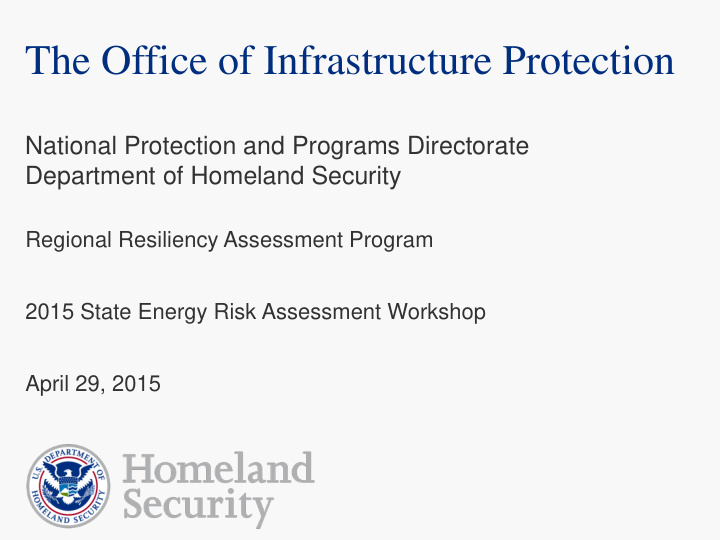



The Office of Infrastructure Protection National Protection and Programs Directorate Department of Homeland Security Regional Resiliency Assessment Program 2015 State Energy Risk Assessment Workshop April 29, 2015
Department of Homeland Security The Department of Homeland Security (DHS) is charged to “provide strategic guidance, promote a national unity of effort, and coordinate the overall Federal effort to promote the security and resilience of the Nation's critical infrastructure” (Presidential Policy Directive – 21) The National Protection and Programs Directorate’s Office of Infrastructure Protection is the Department’s lead in the national coordination effort 2
Regional Resiliency Assessment Program The Regional Resiliency Assessment Program (RRAP) began in 2009 as a pilot program out of efforts to assess security of individual critical assets The goal is to identify opportunities for regional homeland security officials and critical infrastructure partners to strengthen resilience to all hazards The RRAP process identifies critical infrastructure security and resilience gaps; dependencies; interdependencies; cascading effects; and State, local, tribal, and territorial government capability gaps 3
Protective Security Advisors Regional Directors oversee and manage the PSA program in their respective region PSAs are field-deployed personnel who serve as critical infrastructure security specialists Deployed to 73 districts in 50 States and Puerto Rico SLTT and private sector link to DHS infrastructure protection resources Coordinate vulnerability assessments, training, and other DHS products and services Provide a vital link for information sharing in steady state and incident response Assist facility owners and operators with obtaining security clearances During contingency events, PSAs support the response, recovery, and reconstitution efforts of the States by serving as pre-designated Infrastructure Liaisons (IL) and Deputy ILs at the Joint Field Offices 4
Past RRAP Projects Conducted 45 RRAP projects from Fiscal Year 2009 – Fiscal Year 2014 Diverse set of critical infrastructure topics, sectors, and regions Major categories of Key Findings have included: Identification and enhanced assurance of infrastructure dependencies Mitigation of physical vulnerabilities Closure of gaps in planning, procedures, analysis, and training 5
RRAP Projects 2009-2015 Courtesy of DHS 6
RRAP Project Overview Primary activities result in Resiliency Assessment Report Project elements include outreach, scoping, assessments, workshops and interviews, modeling and analysis, documenting results, risk mitigation training, and follow-up Regional partners build on initial project phase through follow- on analysis and implementation activities RRAP team can provide limited support for activities in the implementation phase 7
Documenting RRAP Results RRAP projects culminate with a Resiliency Assessment Report centered around a set of Key Findings Key Findings concentrate on regionally-significant issues tied to the RRAP project focus and present options for consideration for enhanced resilience The Resiliency Assessment Report is delivered as a part of a Multimedia Presentation that may include other RRAP products and background materials 8
RRAP Key Findings Key Findings have the following characteristics: Carefully documented based on RRAP analysis results Reviewed by State and local officials Serve as the basis for follow-up activities, including post- RRAP project exercises, analysis, and improvements Present opportunities for valuable cross-jurisdictional and cross-sector cooperation 9
Benefits of the RRAP Data, analysis, and Key Findings can support existing or new infrastructure resilience enhancement efforts Identify critical cross-sector issues, operational dependencies/chokepoints, planning/communications gaps, etc. Confirm known resilience issues Propose solutions inclusive of less traditional partners Unique opportunity for relationship building, enhanced coordination and broader awareness among diverse, yet interconnected stakeholders 10
Support for Enhancing Resilience Fiscal Year 2014 Homeland Security Grant Program Addressing Resilience Enhancement Options described in an RRAP Resiliency Assessment Report and overtime for RRAP project participation as allowable expenses Public-private partnerships are encouraged; funding for purchases is not always necessary to implement resilience enhancement options RRAP project team can provide limited support for implementing resilience enhancement options 11
Electrical Dependency Analysis Earlier RRAP projects rarely focused on electric providers or the electrical grid itself Often, RRAP projects focus on other critical assets, examining their dependence on electricity along with discussion of how electrical disruptions affect them Degree of focus on electrical dependencies varies by RRAP project and is based on the scope and the particular facilities involved 12
Electricity in the RRAP Several projects have focused on the lifeline infrastructure supporting major metropolitan areas, to include the examination of the electric power dependencies Other projects have had Key Findings that addressed specific electric power industry infrastructure, for example: Vulnerabilities in electric transmission system Primary source vulnerabilities to regional electric power generation 13
For more information, visit: www.dhs.gov/critical-infrastructure Jamie Richards Operations Chief Jamie.Richards@hq.dhs.gov
Recommend
More recommend